Bed Load Transport in Channels with Vegetated Banks
Abstract
1. Introduction
Field Studies
2. Materials and Methods
2.1. Field Data Collection
2.1.1. Site Selection
2.1.2. Flow Measurements
2.2. Laboratory Experiments
2.3. Calculations
2.3.1. Estimation of Bed Load Rate
2.3.2. Determination of Shear Velocity
2.3.3. Determination of Shields Parameter
2.4. Assumptions and Limitations
3. Results and Discussion
3.1. Sediment Granulation
3.2. Velocity Distribution
3.3. Bed Shear Stress
3.4. Variations in Shields Parameter and Bed Load
3.5. Measurement Uncertainty and Limitations
3.6. Bed Load Transport Affected by the Channel Geometry
4. Conclusions
- (1)
- The velocity profiles along the central axis of the river are more uniform compared to those near the vegetated riverbank. Most velocity profiles near the vegetated bank exhibit a dip phenomenon, suggesting the formation of secondary currents caused by the presence of vegetation.
- (2)
- As the flow approaches the vegetated bank, it is redirected towards the non-vegetated bank, leading to higher flow velocities near the non-vegetated side. An increase in bed material grain size is associated with higher velocities and reduced irregularity in the velocity profiles.
- (3)
- Based on the experiments conducted, it was confirmed that the presence of vegetation along the channel bank creates a minimum shear stress near the vegetated bank and a maximum along the flume’s central axis. The shear stress distribution adjacent to the vegetated bank exhibits a convex profile, indicating a gradual reduction in shear stress toward the channel bed. In contrast, regions farther from the vegetated bank show a quasi-linear distribution with comparatively higher shear stress values.
- (4)
- The locations of maximum bed load transport coincide with the positions of the maximum Shields parameter and the deepest flow points. The presence of vegetation along the channel introduces additional hydraulic resistance, altering the flow structure by reducing near-bed velocity and turbulence intensity. These changes result in lower Shields parameter values and consequently suppress bedload transport.
- (5)
- Based on both field and laboratory observations, shear velocity consistently exhibits a convex distribution pattern rather than a linear one. This behavior is attributed to flow retardation caused by sediment in the bed and vegetation along the channel banks. Similar trends were observed in both river and laboratory channels. Further studies are needed to validate these findings and to compare results from field investigations with those from laboratory experiments. We recommend assessing the effects of different vegetation types such as flexible versus rigid and submerged versus emergent on sediment transport. Additional research should also explore a wider range of flow conditions and sediment sizes to confirm and extend the current findings. Moreover, long-term monitoring in natural rivers could help reveal the cumulative impacts of vegetation on bed morphology under variable flow regimes.
- (6)
- The novelty of this research lies in its integrated approach, combining field and laboratory data to assess the effects of bank vegetation on sediment transport—an aspect seldom evaluated under both real and controlled conditions.
- (7)
- In summary, the novelty of this research lies in its integrated use of field and laboratory data to assess the effects of bank vegetation on sediment transport—an area rarely evaluated under both real and controlled conditions. Additionally, the study offers new insights into the decoupling of the Shields parameter from bedload response, particularly along vegetated banks, which remains an understudied topic.
Author Contributions
Funding
Data Availability Statement
Conflicts of Interest
References
- Iqbal, S.; Tanaka, N. Hydraulic Performance Assessment of Various Submerged Pile Designs around an Emerged Dike. Water Sci. Eng. 2024, 17, 406–416. [Google Scholar] [CrossRef]
- Iqbal, S.; Tanaka, N. An Experimental Investigation on Dike Stabilization against Floods. Geosciences 2023, 13, 307. [Google Scholar] [CrossRef]
- D’Ippolito, A.; Calomino, F.; Dey, S.; Gaudio, R.; Penna, N. Bedload transport through emergent vegetation: Current status and its future prospect. Environ. Fluid Mech. 2023, 23, 711–733. [Google Scholar] [CrossRef]
- Nikora, V.I.; Goring, D.G.; Biggs, B.J.F. On gravel-bed roughness characterization. Water Resour. Res. 1999, 35, 3973–3983. [Google Scholar] [CrossRef]
- Nikora, V. Hydrodynamics of aquatic ecosystems: An interface between ecology, biomechanics and environmental fluid mechanics. River Res. Appl. 2010, 26, 367–384. [Google Scholar] [CrossRef]
- Nepf, H.M. Hydrodynamics of vegetated channels. J. Hydraul. Res. 2012, 50, 262–279. [Google Scholar] [CrossRef]
- Yang, J.Q.; Nepf, H.M. A turbulence-based bed-load transport model for bare and vegetated channels. Geophys. Res. Lett. 2018, 45, 10428–10436. [Google Scholar] [CrossRef]
- Shan, Y.; Zhao, T.; Liu, C.; Nepf, H. Turbulence and Bed Load Transport in Channels with Randomly Distributed Emergent Patches of Model Vegetation. Geophys. Res. Lett. 2020, 47, e2020GL087055. [Google Scholar] [CrossRef]
- Baptist, M.J. A flume experiment on sediment transport with flexible, submerged vegetation. In International Workshop on Riparian Forest Vegetated Channels: Hydraulic, Morphological and Ecological Aspects; RIPFOR: Trento, Italy, 2003. [Google Scholar]
- Tang, H.W.; Wang, H.; Liang, D.F.; Lv, S.Q.; Yan, L. Incipient motion of sediment in the presence of emergent rigid vegetation. J. Hydro-Environ. Res. 2013, 7, 202–208. [Google Scholar]
- Shahmohammadi, R.; Afzalimehr, H.; Sui, J. Impacts of turbulent flow over a channel bed with a vegetation patch on the incipient motion of sediment. Can. J. Civ. Eng. 2018, 45, 803–816. [Google Scholar] [CrossRef]
- Yager, E.M.; Schmeeckle, M.W. The influence of vegetation on turbulence and bed load transport. J. Geophys. Res. Earth Surf. 2013, 118, 1585–1601. [Google Scholar] [CrossRef]
- Wang, H.; Tang, H.W.; Zhao, H.Q.; Zhao, X.Y.; Lü, S.Q. Incipient motion of sediment in presence of submerged flexible vegetation. Water Sci. Eng. 2015, 8, 63–67. [Google Scholar] [CrossRef]
- Tabesh Mofrad, M.R.T.; Afzalimehr, H.; Parvizi, P.; Ahmad, S. Comparison of Velocity and Reynolds Stress Distributions in a Straight Rectangular Channel with Submerged and Emergent Vegetation. Water 2023, 15, 2435. [Google Scholar] [CrossRef]
- Specht, F.J.; Koll, K. Adaptation of bed-load transport formulas for vegetated banks. In Volume 2 “Model Application for Wetlands Hydrology and Hydraulics” of the Conference Wethydro; Center of Excellence in Wetland Hydrology: Bialistok, Poland, 2004. [Google Scholar]
- Anderson, B.G.; Rutherfurd, I.D.; Western, A.W. An analysis of the influence of riparian vegetation on the propagation of flood waves. Environ. Model. Softw. 2006, 21, 1290–1296. [Google Scholar] [CrossRef]
- Rutherfurd, I.; Anderson, B.; Ladson, A. Managing the effects of riparian vegetation on flooding. In Principles for Riparian Lands Management; Lovett, S., Price, P., Eds.; Land and Water Australia: Canberra, Australia, 2007; pp. 63–84. [Google Scholar]
- Clayton, J.A.; Pitlick, J. Spatial and temporal variations in bed load transport intensity in a gravel bed river bend. Water Resour. Res. 2007, 43, W02426. [Google Scholar] [CrossRef]
- Frings, R.M.; Kleinhans, M.G.; Vollmer, S. Discriminating between pore-filling load and bed-structure load: A new porosity-based method, exemplified for the river Rhine. Sedimentology 2008, 55, 1571–1593. [Google Scholar] [CrossRef]
- Dodangeh, E.; Afzalimehr, H. Incipient motion of sediment particles in the presence of bed forms under decelerating and accelerating flows. J. Hydrol. Hydromech. 2022, 70, 89–102. [Google Scholar] [CrossRef]
- Emmett, W.W. A Field Calibration of the Sediment-Trapping Characteristics of the Helley-Smith Bedload Sampler; U.S. Geological Survey Professional Paper 1139; U.S. Government Printing Office: Washington, DC, USA, 1979. [Google Scholar]
- Bridge, J.S.; Gabel, S.L. Flow and sediment dynamics in a low sinuosity, braided river: Calamus River, Nebraska Sandhills. Sedimentology 1992, 39, 125–142. [Google Scholar] [CrossRef]
- Ghani, A.A.; Ariffin, J.; Azazizakaria, N.; Shukriyahya, A.; Abdul-Talib, S. Error introduced in measurements of bed load transport. In Advances in Hydraulics and Water Engineering, Proceedings of the 13th IAHR–APD Congress, Singapore, 6–8 August 2002; Imperial College Press: London, UK, 2002; pp. 195–198. [Google Scholar]
- Bunte, K.; Swingle, K.W.; Ettema, R.; Abt, S.R.; Cenderelli, D.A. Bedload traps and Helley-Smith Sampler Collect Different Rates and Particle Sizes of Gravel Bedload. In Proceedings of the SEDHYD 2019, 11th Federal Interagency Sedimentation and 6th Hydrologic Modeling Conference, Reno, NV, USA, 24–28 June 2019. [Google Scholar]
- Gaudet, J.M.; Roy, A.G.; Best, J.L. Effect of orientation and size of Helley-Smith sampler on its efficiency. J. Hydraul. Eng. 1994, 120, 758–766. [Google Scholar] [CrossRef]
- Bonilla-Porras, J.A.; Armanini, A.; Crosato, A. Extended Einstein’s parameters to include vegetation in existing bedload predictors. Adv. Water Resour. 2021, 152, 103928. [Google Scholar] [CrossRef]
- Jordanova, A.A.; James, C.S. Experimental study of bed load transport through emergent vegetation. J. Hydraul. Eng. 2003, 129, 474–478. [Google Scholar] [CrossRef]
- Kothyari, U.C.; Hashimoto, H.; Hayashi, K. Effect of tall vegetation on sediment transport by channel flows. J. Hydraul. Res. 2009, 47, 700–710. [Google Scholar] [CrossRef]
- Afzalimehr, H.; Rennie, C.D. Determination of bed shear stress in gravel-bed rivers using boundary-layer parameters. Hydrol. Sci. J. 2009, 54, 147–159. [Google Scholar] [CrossRef]
- Church, M. Bed material transport and the morphology of alluvial river channels. Annu. Rev. Earth Planet. Sci. 2006, 34, 325–354. [Google Scholar] [CrossRef]
- Zhao, T.; Nepf, H.M. Turbulence dictates bedload transport in vegetated channels without dependence on stem diameter and arrangement. Geophys. Res. Lett. 2021, 48, e2021GL095316. [Google Scholar] [CrossRef]
- Mueller, E.R.; Pitlick, J.; Nelson, J.M. Variation in the reference Shields stress for bed load transport in gravel-bed streams and rivers. Water Res. 2005, 41, W04006. [Google Scholar] [CrossRef]
- Fenton, J.D.; Abbott, J.E. Initial movement of grains on a stream bed: The effect of relative protrusion. Proc. R. Soc. Lond. A Math. Phys. Sci. 1977, 352, 523–537. [Google Scholar]
- Lamb, M.P.; Dietrich, W.E.; Sklar, L.S. A model for fluvial bedrock incision by impacting suspended and bed load sediment. AGU J. Geophys. Res. 2008, 113, F03025. [Google Scholar] [CrossRef]
- Afzalimehr, H.; Dey, S.; Rasoulianfar, P. Influence of decelerating flow on incipient motion of a gravel-bed stream. Sadhana 2007, 32, 545–559. [Google Scholar] [CrossRef]
- Motamedi, A.; Afzalimehr, H.; Singh, V.J. Evaluation of a novel approach to determine the critical Shields stress. J. Hydrol. Eng. ASCE 2010, 15, 892–900. [Google Scholar] [CrossRef]
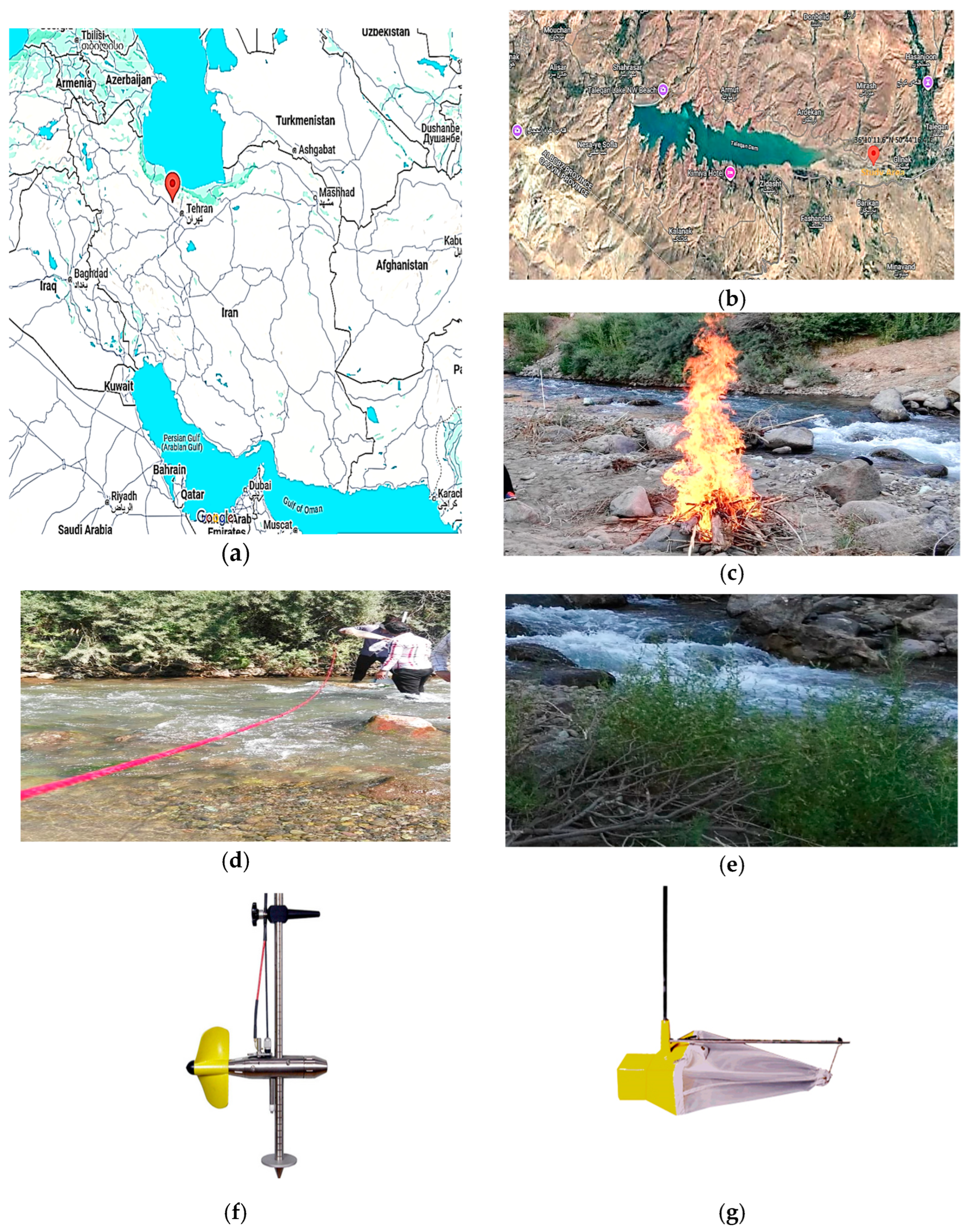

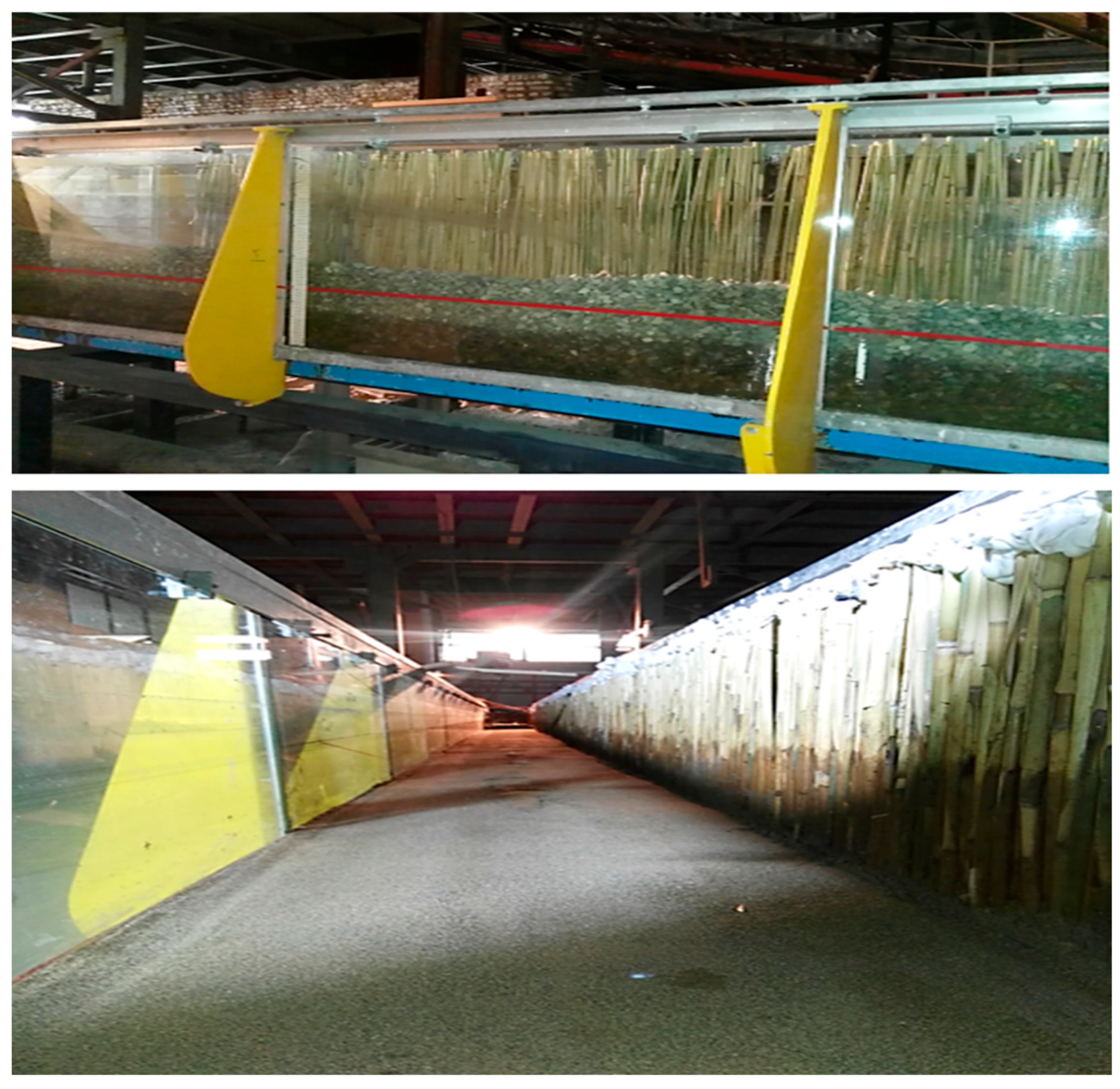



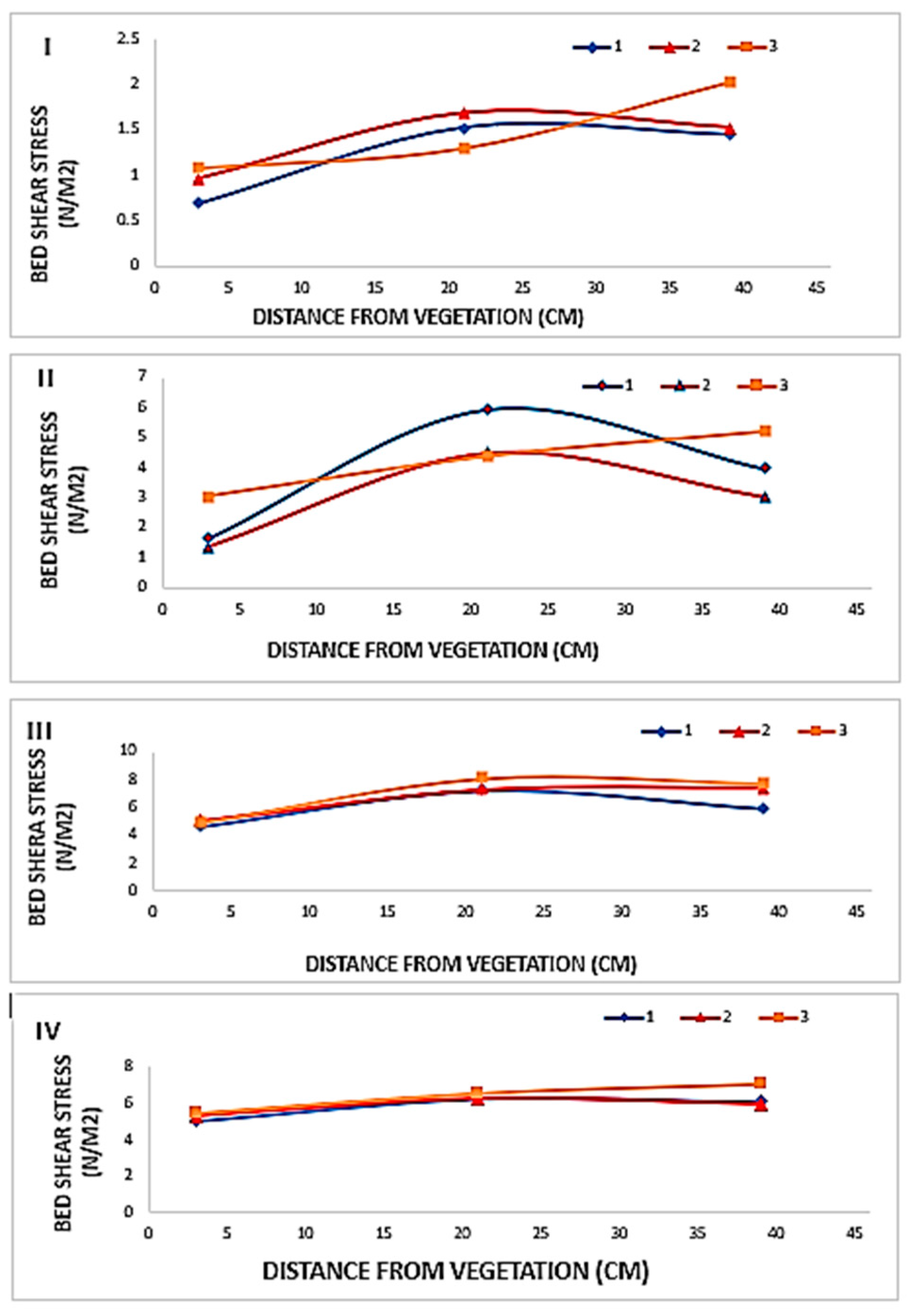
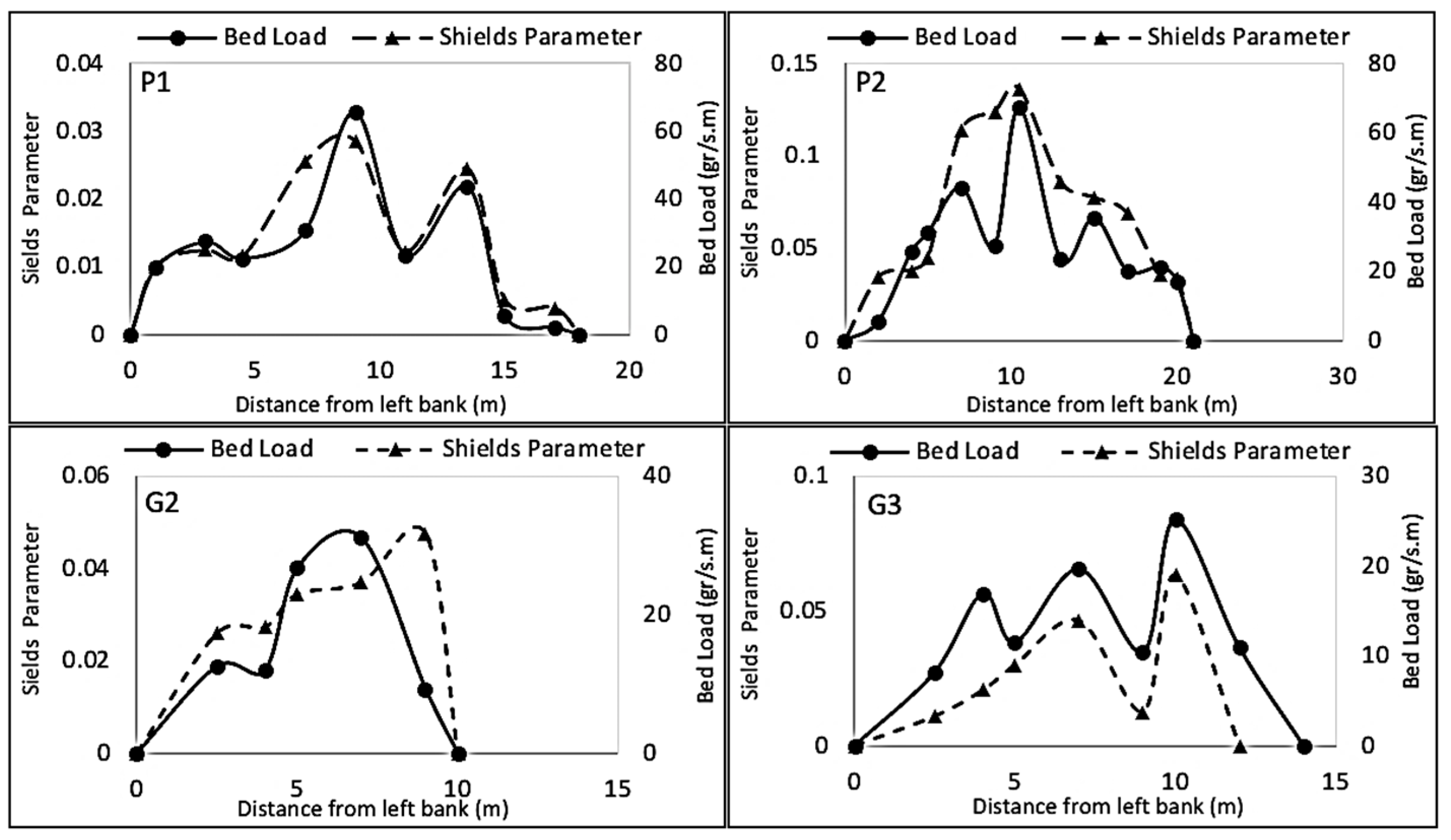

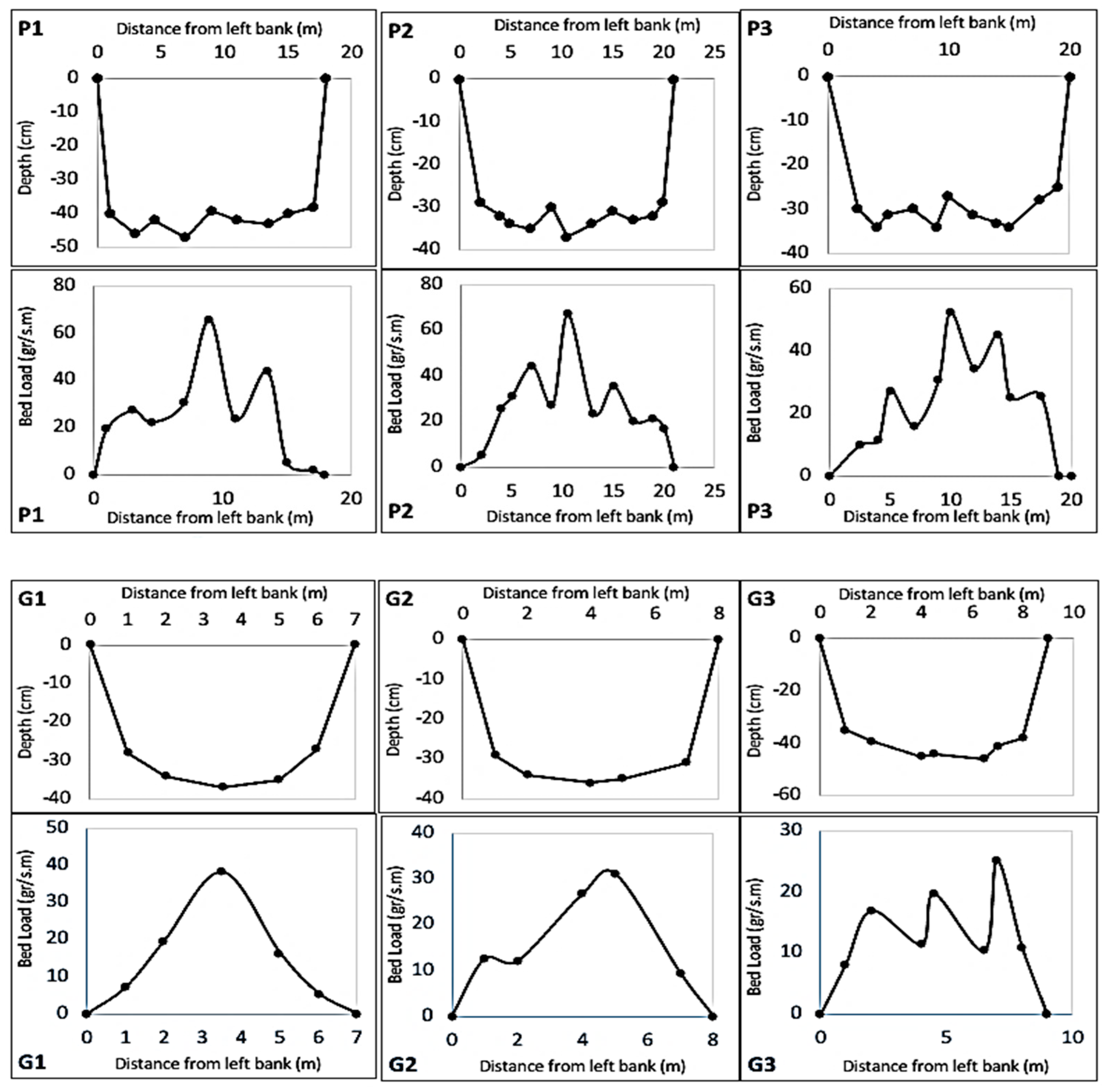
| Name of River Reach | Name of Cross-Section | D50 (mm) | d50 (mm) | h (m) | A (m2) | T (m) | d50/h | T/h |
|---|---|---|---|---|---|---|---|---|
| Pol-Vashteh | P1 | 19 | 6.4 | 0.39 | 7.15 | 18.0 | 0.048 | 46.15 |
| P2 | 19 | 6.0 | 0.30 | 6.35 | 21.0 | 0.063 | 70.00 | |
| P3 | 19 | 5.8 | 0.28 | 5.58 | 20.0 | 0.068 | 71.42 | |
| Gouran | G1 | 42 | 11.1 | 0.28 | 1.97 | 7.0 | 0.150 | 25.00 |
| G2 | 42 | 10.2 | 0.29 | 2.33 | 8.0 | 0.144 | 27.58 | |
| G3 | 42 | 8.1 | 0.37 | 3.31 | 9.0 | 0.116 | 24.32 |
| Experiments Run | Vegetated Flume Side | Bed Material | Discharge (L/s) |
|---|---|---|---|
| I | Yes | Fine sand | 23 |
| II | Yes | Fine sand | 45 |
| III | Yes | Very fine gravel | 45 |
| IV | No | Very fine gravel | 45 |
| Particle Group Classification | D (mm) | d16 (mm) | d50 (mm) | d84 (mm) | d90 (mm) | σg |
|---|---|---|---|---|---|---|
| fine sand | 0.18 | 0.19 | 0.24 | 0.41 | 0.50 | 1.46 |
| Very fine gravel | 0.18 | 1.60 | 2.10 | 3.10 | 3.40 | 1.39 |
| Distance From Left Bank | Sampling Duration (s) | Repetitions Number | Depth (cm) | Sample Dry Weight (gr) | Sample Dry Weight (gr/s) | Sample Dry Weight (gr/s.m) |
|---|---|---|---|---|---|---|
| 0 | 0 | 0 | 0 | 0 | 0 | 0 |
| 1.0 | 120 | 5 | 40 | 425 | 3.54 | 46.47 |
| 3.0 | 120 | 5 | 46 | 210 | 1.75 | 22.96 |
| 4.5 | 120 | 5 | 42 | 155 | 1.29 | 16.95 |
| 7.0 | 120 | 5 | 47 | 235 | 1.95 | 25.69 |
| 9.0 | 120 | 5 | 39 | 105 | 0.875 | 11.48 |
| 11.0 | 120 | 5 | 42 | 150 | 1.25 | 16.40 |
| 13.5 | 120 | 5 | 43 | 190 | 1.58 | 20.77 |
| 15.0 | 120 | 5 | 40 | 90 | 0.75 | 9.84 |
| 17.0 | 120 | 5 | 38 | 70 | 0.58 | 7.65 |
| 18.0 | 0 | 0 | 0 | 0 | 0 | 0 |
| Reach Name | CS | Ueq | Umax | Q | q | Qs | qs | Fr | Re × 105 | τ | |
|---|---|---|---|---|---|---|---|---|---|---|---|
| P1 | 0.56 | 0.892 | 3.673 | 0.204 | 15.40 | 0.85 | 0.26 | 1.31 | 5.78 | 0.0198 | |
| Pol-Vashteh | P2 | 0.96 | 1.733 | 5.855 | 0.278 | 23.24 | 1.11 | 0.53 | 1.82 | 27.93 | 0.0771 |
| P3 | 1.12 | 1.675 | 5.65 | 0.282 | 27.54 | 1.37 | 0.62 | 1.79 | 27.34 | 0.0791 | |
| G1 | 0.632 | 0.973 | 0.961 | 0.137 | 5.66 | 0.81 | 0.29 | 0.9 | 13.64 | 0.0227 | |
| Gouran | G2 | 0.884 | 1.25 | 1.807 | 0.225 | 7.93 | 0.99 | 0.42 | 1.36 | 15.44 | 0.039 |
| G3 | 0.800 | 1.22 | 2.206 | 0.245 | 8.03 | 0.89 | 0.35 | 1.57 | 14.72 | 0.0482 |
| Reach Name | (mm) | (mm) | (mm) | (mm) | |
|---|---|---|---|---|---|
| Pol-Vashteh | 13.5 | 19.0 | 28.0 | 28.8 | 1.44 |
| Gouran | 19 | 28 | 38 | 45 | 1.41 |
| Test Number | CS Number | Axis-A | Axis-B | Axis-C | |
|---|---|---|---|---|---|
| 1 | 0.696 | 1.521 | 1.44 | 1.26 | |
| Series I | 2 | 0.961 | 1.681 | 1.521 | 1.38 |
| 3 | 1.076 | 1.296 | 2.025 | 1.43 | |
| 1 | 1.66 | 5.92 | 3.96 | 4.16 | |
| Series II | 2 | 1.37 | 4.48 | 3.02 | 3.16 |
| 3 | 3.02 | 4.35 | 5.18 | 4.11 | |
| 1 | 4.62 | 7.22 | 5.92 | 5.56 | |
| Series III | 2 | 5.04 | 7.22 | 7.39 | 6.32 |
| 3 | 4.9 | 8.1 | 7.74 | 6.81 | |
| 1 | 5.04 | 6.24 | 6.08 | 5.38 | |
| Series IV | 2 | 5.27 | 6.24 | 5.92 | 5.34 |
| 3 | 5.47 | 6.56 | 7.06 | 5.94 |
Disclaimer/Publisher’s Note: The statements, opinions and data contained in all publications are solely those of the individual author(s) and contributor(s) and not of MDPI and/or the editor(s). MDPI and/or the editor(s) disclaim responsibility for any injury to people or property resulting from any ideas, methods, instructions or products referred to in the content. |
© 2025 by the authors. Licensee MDPI, Basel, Switzerland. This article is an open access article distributed under the terms and conditions of the Creative Commons Attribution (CC BY) license (https://creativecommons.org/licenses/by/4.0/).
Share and Cite
Jalilian, F.; Dodangeh, E.; Afzalimehr, H.; Sui, J.; Ahmadi, K. Bed Load Transport in Channels with Vegetated Banks. Water 2025, 17, 1758. https://doi.org/10.3390/w17121758
Jalilian F, Dodangeh E, Afzalimehr H, Sui J, Ahmadi K. Bed Load Transport in Channels with Vegetated Banks. Water. 2025; 17(12):1758. https://doi.org/10.3390/w17121758
Chicago/Turabian StyleJalilian, Fatemeh, Esmaeil Dodangeh, Hossein Afzalimehr, Jueyi Sui, and Kamran Ahmadi. 2025. "Bed Load Transport in Channels with Vegetated Banks" Water 17, no. 12: 1758. https://doi.org/10.3390/w17121758
APA StyleJalilian, F., Dodangeh, E., Afzalimehr, H., Sui, J., & Ahmadi, K. (2025). Bed Load Transport in Channels with Vegetated Banks. Water, 17(12), 1758. https://doi.org/10.3390/w17121758





